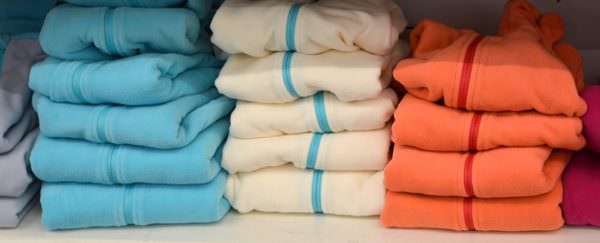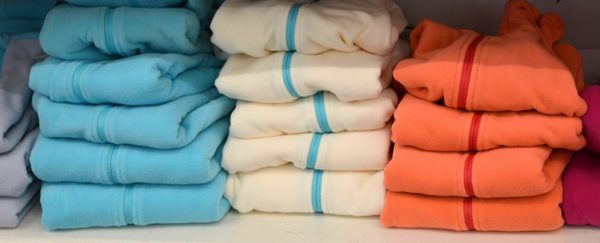Some people will argue that following fashion trends is shallow. But at least one aspect of fashion deserves everyone’s attention. The fashion industry is responsible for 10% of annual global carbon emissions.
Whether you follow the trends or not, we suggest using thredUP’s fashion footprint calculator to estimate the impact of your wardrobe. You may be inspired to cut the consumer footprint of your closet by buying less or shopping more sustainable clothing brands.
In general, synthetic fabrics require more energy to manufacture than natural fibers, which results in greater climate impact. But natural fibers are often more damaging in terms of immediate environmental impacts such as land use, water consumption, and chemical pollution. And most performance clothing – like swimsuits, athletic wear, and outdoor gear – is only made from synthetics. The question, then, is one kind of synthetic fabric better than the rest?

Not So Good (and better to avoid)
Polyester, Acrylic, Nylon
From an environmental point of view, polyester, acrylic, and nylon are all similar synthetic fabrics. Like plastic, they are manufactured from oil. Petrochemical-based synthetics make up 65% of all fibers produced annually, with polyester by far the most widely used synthetic fabric. Compared to cotton, polyester has a lower water footprint and has to be washed at lower temperatures, which reduces post-consumer energy use. But emissions from a single polyester T-shirt are estimated at 5.5 kg CO2-eq, compared with 2.1 kg CO2-eq for a T-shirt made from cotton.
Recycling polyester requires less energy than producing it new, thus resulting in fewer greenhouse gas emissions. But most recycled polyester is made from plastic bottles. Once hailed as a sustainable solution for plastic waste, microfiber fleeces and other textiles recycled from plastic are now understood to be a dangerous source of plastic pollution. That’s because they release microfibers when washed.
In its report A New Textiles Economy, the Ellen Macarthur Foundation identifies the elimination of microfibers released by plastic-based textiles, such as polyester, acrylic, and nylon as a primary goal for making fashion more sustainable. They suggest developing new materials and technologies to reduce microfiber shedding and to recapture shed microfibers. Until then, it’s good to avoid the plastic-based fabrics polyester, acrylic, and nylon.

Synthetic fleece clothing is a source of dangerous microplastic pollution.
Better
Biosynthetics
Biobased polyester (aka biosynthetics) is made at least partly from renewable resources such as corn, sugar cane, beet, or plant oils.
Biosynthetics are a better choice than plastic-based synthetic fabrics in most cases but definitive data is not yet available. The production of biosynthetics is complex and highly variable. Their environmental impacts depend a lot on whether farmers use sustainable agricultural practices to grow the source materials. Unfortunately, sustainable agriculture is not yet widespread outside of food crops so it is difficult to track where biosynthetic materials come from and the environmental impact. Consequently, you cannot buy these materials with complete confidence that it will avoid harming the planet.
Compared to common materials like cotton and polyester, biosynthetics are very new and rare. Although they can still be considered emerging materials, biosynthetic fabrics are already in use under various brand names in a wide variety of products, including athletic gear and outerwear. In clothing, they are often used in small quantities as part of complex blends with other, less sustainable fabrics. As a result, they are harder to recycle.
Manmade Cellulosics
Often classified as natural fabrics because they are usually made from cellulose extracted from wood, cellulosic fibers include rayon (aka viscose) and acetate. The production process is energy-intensive, uses toxic solvents, and has been implicated in illegal logging. However, better production methods using certified wood and less toxic, recycled solvents are catching on.
Cellulosic fibers have lower impacts from land use, dyeing, and finishing processes than cotton. Because they are plant-based, manmade cellulosics are better choices than plastic-based synthetics. Tencel rayon in particular is known for higher standards and better sustainability.

Bottom line: Get the clothing you need and wear it out. Photo: Free-Photos, Pixabay
Best (still a compromise)
Humanity is still a long way from a sustainable and affordable clothing manufacturing infrastructure. We need more information as consumers about where our clothing comes from, what it is made with, and how to recycle materials when we finish using them. That means shopping sustainably means finding a compromise between price and performance.
Synthetic fabrics are petroleum products, and so have an outsized climate impact. They also contribute to plastic pollution, for which there is currently no reliable clean-up method. However, if you use the clothing until it is ready for recycling, then follow through by recycling it, synthetics are often the most affordable choice.
Although they have their own, significant environmental impacts, natural fibers are generally preferable to synthetic ones. However, synthetic fabrics are usually more affordable than natural ones, and often have technical advantages that render them necessary.
So, what if you can’t afford the wool skirt, need a Gore-Tex jacket to get through a wet winter, or need a breathable pair of stretchy pants to get through a workout? It’s best to go ahead and buy the clothes that meet your needs, whatever fabric they are made from. But don’t buy more than you need. Wear the rayon skirt to pieces, and don’t replace the waterproof jacket next year just because you like that season’s new color.
Before you shop, apply consumer carbon footprint reduction strategies to your closet. Because regardless of the fabric, buying less is the best choice.
The post Not So Good, Better, Best: Synthetic Fabrics appeared first on Earth 911.








